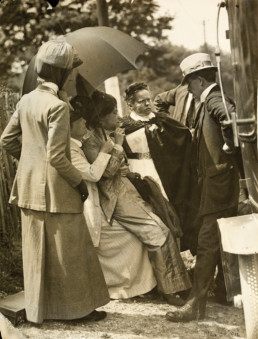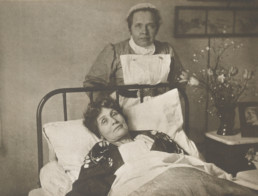Catherine Pine trained at St Bartholomew’s Hospital, now part of City, University of London’s School of Health Sciences. She went on to become an ally of Pankhurst and the suffragette movement.
“I do not come here as an advocate [for women’s suffrage],” Emmeline Pankhurst told a crowd assembled in Connecticut in November 1913, “I come here as a soldier who has temporarily left the field of battle.” In February that year, the women’s rights organiser was sentenced to three years’ penal servitude for inciting the blowing up of a building in Surrey. She immediately went on a hunger strike.
The ‘Cat and Mouse Act’ had just been signed into law to prevent suffragettes from starving themselves to death in police custody; a potential PR disaster for the Government. The Act allowed the discharge of prisoners due to ill health, who would then be surveilled and reimprisoned as soon as they recovered. Over the five months that followed, Pankhurst went through that same cycle: starvation almost to the point of death, release, recuperation and rearrest.
Throughout this period of “civil war”, as Pankhurst called it, between women and the state, there was an ally who can be seen in photographs of the leader’s arrests and convalescences, who was often by her side and aided in the recovery of her health. This businesswoman and health professional was educated at St Bartholomew’s Hospital, many decades before it was renamed St Bartholomew School of Nursing and Midwifery and soon after it was incorporated into City’s School of Health Sciences. Her name was Catherine Pine, but in the writings of the suffragettes whom she aided she was occasionally known as ‘Piney’ and, more frequently, simply as ‘Nurse Pine’.
Catherine Pine was born in 1864 in Maidstone, Kent and educated at St Bart’s between 1895 and 1897. Elizabeth Crawford’s book The Women’s Suffrage Movement: A Reference Guide reports that during her training, she was described as being “punctual, very kind and attentive, very patient and even tempered, obedient, accurate and clean and neat in person and work”. Ward sisters, the entry continues, recorded that “she will make a very good nurse” and that she was “a nice, sensible woman”.

After qualifying, Pine stayed on at St Bartholomew’s, working as a hospital sister, until 1907. The following year, she and another Bart’s graduate, Gertrude Townend, founded their own private nursing home in a villa called Pembridge Gardens in Notting Hill. The two didn’t just have their alma mater in common; they were also both members of the Women’s Social and Political Union (WSPU), the leading militant organisation campaigning for women’s suffrage in the UK.
It was to this nursing home that Emmeline Pankhurst took her son Harry when he became seriously ill with polio, with Catherine Pine among those who cared for him. He could not be saved however and died two years later at the age of 20.
It may have been this initial connection between Pankhurst and Pine that first forged their friendship; what is known is that Pine and Townend’s nursing home became popular among suffragettes recuperating after imprisonment. After the Cat and Mouse Act was passed, it was there, for a time, that militant campaigners for the women’s vote went to be nursed back to health between stretches of incarceration.
Beverley Cook, Curator of Social and Working History at the Museum of London, oversees the museum’s collection of artefacts related to women’s suffrage. She says that Pembridge Gardens became the obvious place for suffragettes to recuperate, because “they needed a safe place to recover and a nursing home that was supportive to the campaign was an obvious choice”. This, she adds, “was potentially a difficult thing to do, which could have affected business quite badly if people objected. [Pine] was prepared to risk the reputation of her business. She never served terms of imprisonment herself, or undertook direct action, such as window smashing, but obviously her contribution was huge”.
In a telephone conversation, author Elizabeth Crawford confirms this account, explaining that Nurse Pine “was never involved in militancy herself”, although records do show that her colleague, Nurse Townend, was injured in a tussle with the police in 1913 at a meeting at Bow Baths Hall at which Sylvia Pankhurst, Emmeline’s daughter, was the speaker.
In fact, she adds, Catherine Pine’s adherence to the law was steadfast; she wouldn’t even be persuaded to allow women on release from prison under the Cat and Mouse Act to escape from her nursing home, because she would have been aiding and abetting. At other houses, these escapes would have been facilitated. “As far as I know, she stayed on the right side of the law all the time while looking after all the suffragettes,” says Crawford.
By 1913, it was well known that the nursing home in Pembridge Gardens was housing Pankhurst and other suffragettes. It became “so besieged by detectives and onlookers,” Crawford writes in her reference guide to the suffrage movement, that Pine began caring for Pankhurst at other safe houses in London and Surrey.

The bond between the two women continued even after the outbreak of the First World War, when Emmeline Pankhurst decided to halt all militant suffrage activities to show support for Britain, until fighting on the mainland ended. During this period, Pankhurst became an advocate for the war effort and for the plight of so-called ‘war babies’ (children born to single mothers whose fathers were on the front lines). She established an adoption home for these children and placed Catherine Pine in charge of running it.
In 1920, Pine joined the Pankhursts, with the four war babies that they had gone on to adopt, as they travelled to America and then Canada the following year. Pine returned to England in 1923, where she lived until her own death in 1941. She was buried in Chatham, Kent. While her name hasn’t become as well known as the activists she aided, those interested in her story can find artefacts relating to her on display at more than one London institution.
A suffragette medal donated by Pine, which may have once belonged to Emmeline Pankhurst, can be found at the British College of Nursing and a collection of photographs assembled by her and donated via a group called the Suffragette Fellowship, in 1950, are in the collection of the Museum of London.
These photographs, originally pasted in a series of scrapbooks which have since been dismantled, offer a valuable snapshot of the campaign for the women’s vote. “The images that the collection has of the campaign are very strong and rich,” Cook says, “and the fact that they’re all together in one place is significant. It is a unique collection.”
The photographs can be viewed online, while some can be seen in the museum’s permanent collection dedicated to the suffrage campaign, along with a new film that is screening during 2018 at the institution to mark one hundred years of the women’s vote. Among them is a shot of Emmeline Pankhurst being arrested in Woking (pictured), while Nurse Pine stands at her side with her hands on her hips and a defiant expression on her face. There are also images of Nurse Pine, in white cap and apron, standing behind Pankhurst’s bed, in which the suffrage leader was recovering from hunger strike.
The nursing school where Pine trained continues to be a boundary-pushing institution today as part of City, ranking first in London for nursing, according to the Complete University Guide 2019. It was Pine’s education there that enabled her to play a supporting role in the fight for the women’s vote, not as a leader who made headlines and tussled with politicians, but as a source of compassion and quiet determination who helped those leaders stay alive.

To mark International Women’s Day in 2018, Catherine Pine was one of two additions to the Extraordinary Women wall display in City’s College Building. The other was Nicole Young (International Journalism, 2003), a multiple Emmy Award-winning producer of CBS’s 60 Minutes.
Archive photography used with kind permission of the Museum of London.

Contributor:
Jessica Holland (Magazine Journalism, 2007) is a freelance journalist, copywriter and editor who has written for The Guardian, Vice and Al Jazeera.
Illustration by Diego Pedauye.